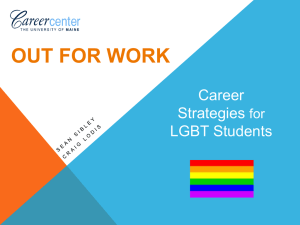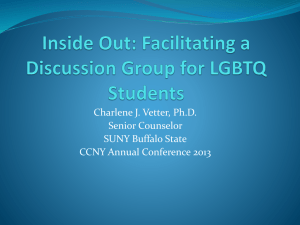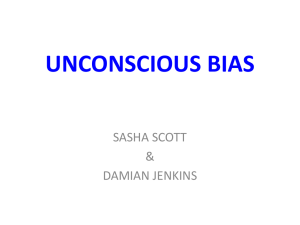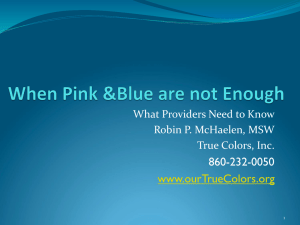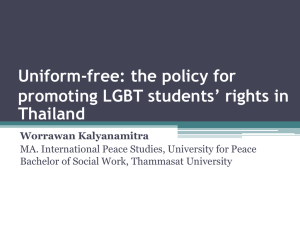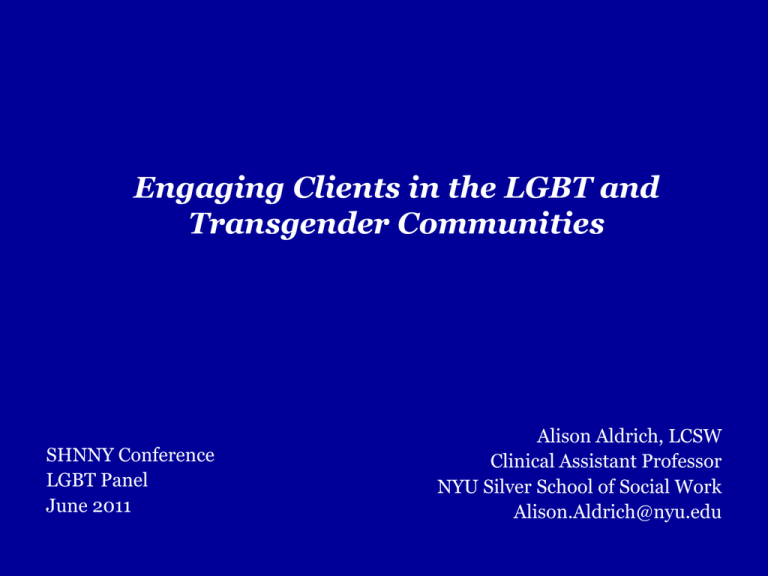
Engaging Clients in the LGBT and
Transgender Communities
SHNNY Conference
LGBT Panel
June 2011
Alison Aldrich, LCSW
Clinical Assistant Professor
NYU Silver School of Social Work
Alison.Aldrich@nyu.edu
Goals and Objectives
•
•
Goals
– To provide an overview of the unique risks and characteristics of the LGBT
and Trans Community
– To provide brief overview of how microagressions in every day life
profoundly impact the lives of Transgender individuals as they attempt to
access services (such as housing, healthcare and substance abuse
treatment)
– To build skills for agency staff, supervisors and practitioners in order to
work more effectively with members of the LGBT communities
Objectives
– Identify and explain differences between the separate continuums of sex,
gender role, gender identity, sexual orientation and basic transgender
terminology
– Examine and assess engagement barriers often present when working with
LGBT and Trans Identified clients
– Begin to define, recognize and deconstruct the destructive power of
microaggressions on the emotional and physical health of Transgender
people
Microaggressions in Everyday Life for Trans People
some material extracted from Microaggressions in Everyday Life; Race Gender and Sexual Orientation by Derald Wing Sue
Straight Americans need... an education of the heart
and soul. They must understand - to begin with - how it
can feel to spend years denying your own deepest
truths, to sit silently through classes, meals, and church
services while people you love toss off remarks that
brutalize your soul.
Bruce Bawer, The Advocate, 28 April 1998
Microaggressive Stress: Impact on Emotional Wellbeing
material extracted from Microaggressions in Everyday Life; Race Gender and Sexual Orientation by Derald Wing Sue
• Overt hate crime represent small portion of oppression faced by
racial and sexual orientation minorities
• The majority of oppression faced by trans individuals are ‘micro’
which are insidious, psychologically and physically draining and
often not definable, illegal or open to redress
• Microaggressions are the constant, continuing everyday reality of
slights, insults, invalidations and indignities upon LGBT people but
particularly on trans individuals
• They are perpertrated by well intentioned, moral, decent family
members, friends, neighbors, co workers, students, teachers, clerks,
waiters, employers, health care workers and educators
‘
Microaggression examples’
material extracted from Microaggressions in Everyday Life; Race Gender and Sexual Orientation by Derald Wing Sue
• Alicia discloses to straight male therapist that she is ‘transgender’
… the therapist responds he’s not shocked as he once had a elderly
male client that said he was ‘into little boys’
• Cathy’s caseworker tells her that she’ll have to go to a men’s
residential drug treatment program, because she’s ‘not really a
woman’ and the other women there will be uncomfortable.
• Rosa tells her caseworker to please call her “Ms. Garcia.” He
replies, “Why should I? I know you’re a guy. You show me that
you’ve had a sex change and then I’ll call you Ms.”
• The intake worker at DV said that they could not accept a
transgender woman because she would scare the women in the
shelter who are vulnerable because of the violence they have
endured.
Percived ‘Minimal Harm’ of Microaggressionis
some material extracted from Microaggressions in Everyday Life; Race Gender and Sexual Orientation by Derald Wing Sue
•
•
•
•
While most of us are willing to admit harmful impact of overt bias and hate
crimes on physical and emotional well being of transgender individuals
Trivializing and minimalizing microagressions by straights often appear to
be a defensive reaction to feeling blamed and guilty
Studies reveal that heterosexism and sexual orientation microaggressions
while trivial in nature has major consequences for the Transgender people.
They have been found to:
1. cause frustration, anger, low self esteem and emotional turmoil
2. create a hostile and invalidating day to day existence
3. perpetuate stereotype threats
4. create physical health problems
5. saturates broader society w/cues that signal devaluation of identities
6. lower work productivities and problem solving abilities
I’m tired of …
some material extracted from Microaggressions in Everyday Life; Race Gender and Sexual Orientation by Derald Wing Sue
•
•
•
•
•
•
•
•
•
•
•
•
Wondering if the kids snickering as I entered the elevator are laughing at
me …
Watching straight people with less skills get job interviews over me …
The deadening silence that occurs when the conversation turns to gender
identity
Wondering if things will ever get better …
Being followed by security guards every time I enter a store
Wondering if the taxi driver really did not see me trying to hail a cab
Being ‘terrified every time I have to use the rest room on the NJ Turnpike
Having to explain why I want to be called by the right pronoun
Being told they are just not ready to have a trans person in their company
Having to explain why I shouldn’t be the object of men’s ‘sexual fantasies’
People telling me ‘things are getting better’
Feeling threatened when approached by a male police officer
Unique Risks & Characteristics of Trans Community
Our right to be different is, in a deep sense, the
most precious right we human beings have
Lillian Smith
Domestic violence access scenario
•
•
Tiffany is a transgender woman who has been involved in a violent relationship
with a boyfriend for the past 18 months. Recently, after Tiffany was hospitalized for
the third time, she came to Housing Program seeking services and benefits in order
to leave the relationship. Tiffany’s caseworker called a women’s shelter that
contracts with her Housing Program to speak about placing Tiffany in the facility.
Tiffany’s caseworker explained to the intake coordinator at the shelter that Tiffany’s
records include her old name, which is still her legal name, Michael. The
caseworker explained that Tiffany met all the criteria for the shelter. The intake
worker, however, said that they could not accept a transgender woman because she
wasn’t really a woman and would scare the women in the shelter who are
vulnerable because of the violence they have endured. She refused to complete the
intake for Tiffany.
What should have happened in this situation?
–
–
–
–
Is this a scenario of discrimination?
Should the intake coordinator have done an intake for Tiffany?
Is Tiffany’s transgender history a basis for refusing her service?
What would you do to intervene?
Trans-woman or trans-man?
some material extracted from Gender Identity Project presentation at the LGBT Community Center
•
Say trans-woman or woman
– To refer to a person who was
assigned male at birth
– And lives and/or identifies as a
woman
– Male Female
•
Say trans-man or man
– To refer to a person who was
assigned female at birth
– And lives and/or identifies as a man
– Female Male
•
Yes, this is a gross
oversimplification
– Best way to know is to ask
– Conforms with the New York City
Human Rights Law
What we need to know about trans-needs and barriers
some material extracted from Gender Identity Project presentation at the LGBT Community Center
• What ideas or thoughts come into your mind when you
think or transgender people seeking health or mental
health services?
• What settings do trans people seek services in?
• What needs or concerns might trans people seek to
address
• What problems of barriers might they encounter?
LGBT risk factor
variables associated w/ increased health risk or concern
some material extracted from Gender Identity Project presentation at the LGBT Community Center
•
Multiple oppressions
– The impact of multiple stigmas and
problems including concurrent
poverty, racism, HIV and AIDS related
issues and/or other concerns
•
Lack of social spaces
– Reliance upon the trans or gay bar
scene or sex-work stroll for
socialization and identity affirmation
•
Disconnection from family and other
institutions
– Family, religious and social
intolerance of LGBT lifestyles
•
Violence
– The threat and/or experience of antigay or anti-trans violence
Trans risk factors
Variables associated with an increased risk or concern
some material extracted from Gender Identity Project presentation at the LGBT Community Center
•
•
•
•
•
Sex role stereotypes
– In particular for trans-women’s
communities
Community myths and lack of
information
Internalized shame and transphobia
– Social marginalization, fringe
existence, survival sex
Unmet medical needs
– Openly hostile providers
Discomfort with and disassociation
from own bodies
– Magical thinking and immunity
belief
•
Insensitive, incongruent outreach
and programs
– Lack of targeted services
– Largely unrecognized and
unique trans risks
Unique risks
some material extracted from Gender Identity Project presentation at the LGBT Community Center
• Trans-Migrants
Many trans-people migrate to
urban centers seekng to
reduce isolation
Others may travel long
distances to seek transspecific services
• Trans Immigrants
Nearly invisible, highly
marginalized, underserved
communities
• Hidden Trans Communities
Partners youth, elders trans
men
Gender non-conformity is punished
Abuse, violation and systemic violence
•
60% of all trans-people have been
victims of violence outside the home
GenderPAC, 1st National Study on TransViolence, 1997
•
Trans-people are 71 to 162 times
more likely to be murdered than the
average person in the United States
1 - Dean Spade, Sylvia Rivera Law Project
2 - Marcus Arana, discrimination investigator with the San
Francisco Human Rights Commission
•
A trans-person is killed every two
(2.25) days somewhere in the world,
160 persons over last 12-months
(only includes reported deaths)
– United States is the 2nd most
dangerous country in the world
after Brazil with over 1-murder
per month
Transgender Europe (TGEU) and the journal,
Liminalis
Disconnection from self, family, friends and
community
Distortion of sexuality especially in regard
Cultural imagery as pathological & deviant
Sexual identity
and gender identity are different things
some material extracted from Gender Identity Project presentation at the LGBT Community Center
•
•
•
•
•
Sexual identity
– How someone identifies their
own sexuality
Sexual orientation
– A pattern of emotional,
romantic, and/or sexual
attractions
Being gay does not mean you’re
trans
Being transgender does not mean
you’re gay
Sexual identity and orientation are
not necessarily ‘gendered’
Cultural differences
Impact transgender sexuality
some material extracted from Gender Identity Project presentation at the LGBT Community Center
•
Cultural variance
– Stigma associated with trans-identities
– Predominant and stereotypical gender
roles
– Religious structures and importance
– Legal status and gender recognition
•
All impact the development of
– Trans identities
•
Brazilian Travesti, Hawaiian Mahu,
Indian Hijra, Islamic Khanith and
Mukhannathun, Islamic Indonesian
Waria, Native American"Two-spirit“,
Serbian Muzana /Albanian Tybeli "sworn virgins”, Thai Ladyboys and
Kathoey, passing women (birth assigned
women who lived as men), passing men
(birth assigned men who lived as
women), eunuchs of many cultures
Gender Management, Trauma & Loss
If God had wanted me otherwise, He would
have created me otherwise.
Johann von Goethe
Restroom access scenario
some material extracted from Gender Identity Project presentation at the LGBT Community Center
Ellen is a caseworker who recently transferred from another
residential facility. Though she is not out as having a
transgender history, a rumor soon spreads that she is a
“pre-op” trans-woman. Her supervisor eventually calls her
into his office and informs her she must use the single stall,
unisex, disability restroom rather than the women’s
restroom, until she has “surgery and is a real woman.”
What should have happened in this situation?
•
•
•
•
Is this is a scenario of discrimination?
How should her supervisor have responded?
What about the concerns of the non-trans women in the office
What would you do to intervene?
Gender identity trauma
Associated with perceiving oneself as non-normative or deviant
some material extracted from Gender Identity Project presentation at the LGBT Community Center
•
•
•
•
Developmental concerns
– Problems or delays
Persistent mental health concerns
– Trans people often have difficulty with relationships as a
result of long term trauma
Peer rejection and/or peer isolation
– One of the most dangerous aspects of a trans-identity
– Peer networks can be tenuous for most trans-people
Identity trauma
– Requiring to manage and repress gender identity
• Childhood
• Adolescence
• Adulthood
Gender management
some material extracted from Gender Identity Project presentation at the LGBT Community Center
•
•
Survival strategies
– Trans folks spend a lot of time
manage their defenses
Strategies of “gender management”
– Can be both adaptive and
maladaptive
• Functional, though often only
temporarily
– Over time they can engender
• Acute confusion, anxiety,
depression
– Family members may also be
effected by ‘trans stigma’
– Potent impact on sexuality
Breakdown of gender management strategies
some material extracted from Gender Identity Project presentation at the LGBT Community Center
•
Prior to transition (pre-transition), individuals often experience behavior or
features associated with trauma, anxiety and depression
– May confuse and frustrate self, family, friends and providers
– May be misdiagnosed as
• Bi-polar disorders or Axis II disorders, especially if not “out” to provider as trans
•
Breakdown will often coincide with the developmental and social tasks
associated with a gender non-affirming
– Adolescence and puberty
– Adulthood
•
Once acknowledged, this is often experienced as
– Intense, overwhelming desire to speed transition or
– Sense of powerlessness or hopelessness
– May generate conflict with
• Economics, age-of-consent, family and coming out needs, education, physical
safety
Intervention
A client-centered and supportive gender transition
some material extracted from Gender Identity Project presentation at the LGBT Community Center
•
•
Respects the clients autonomy
Structured around an active
relationship between client and …
– Family, parent or guardian
•
When possible
– Medical provider experienced in transcare
•
When medical transition is sought
– Mental healthcare provider
experienced in trans-care
•
•
When sought by the client
Other elements can include
– Work, school, religious/spiritual
entities, other family members, peer
groups, social networks, and so forth
Substance Abuse and Mental Health Concerns
Never be bullied into silence. Never allow
yourself to be made a victim. Accept no one's
definition of your life; define yourself.
Harvey Fierstein
Dormitory housing scenario
some material extracted from Gender Identity Project presentation at the LGBT Community Center
• Cathy is a client who who lives in a shelter. Her caseworker is
working to refer Cathy to drug treatment. Cathy is a transgender
woman whose records still list her as Roger and who has not be able
to afford to get a legal name change or change any of her ID. Her
caseworker tells Cathy that she’ll have to go to a men’s residential
drug treatment program, because she’s not really a woman and the
other women there will be uncomfortable.
• What should have happened in this situation?
– Is this a scenario of discrimination?
– How should her caseworker have responded?
– What would you do to intervene?
Substance Use in LGBT and Trans Community
some material extracted from Center CARE Recovery presentation at the LGBT Community Center
• Use substances to facilitate making connections or to maintain
connection
• Use substances to try to feel connected, energized, loved, or
loving when that is not generally their authentic (sober)
experience
• Use substances to deal with hurt and pain in relationships
• Also use in context of relationships with drug-using partners
– To feel connected or joined through use of drugs
Higher Risk Factors for LGBT Community
some material extracted from Center CARE Recovery presentation at the LGBT Community Center
•
•
Risk
Lesbian and gay men are at 2 to 3 times greater risk for alcohol and drug abuse than the
greater population as well as failure to decrease use with age as in the case in the general
population (McKirnan & Peterson,1989; Paul, Stall & Bloomfield, 1991)
Higher rates of abuse among women
Skinner (1994) found higher rates of drinking among lesbians than among women in a
geographically matched sample
(Arday, et. Al. 1993)
•
Tobacco
Prevalence of cigarette smoking among gay men in some studies is a high as 42% compared
to 27% among heterosexual counterparts (Royce and Winkelstein, 1999)
Higher Risk Factors for LGBT Community
Crystal Methamphetamine use …
some material extracted from Center CARE Recovery presentation at the LGBT Community Center
•
•
•
A well-documented crisis especially prevalent among gay, bisexual and
other men who have sex with men
Nationwide
Admissions to treatment for methamphetamine and amphetamine has
increased sharply since 2004 (SAMHSA)
New York City
Studies of crystal methamphetamine use among MSM’s indicate
increasing rates of use over time (Halkitis, et al, 2005)
Early 1990’s – less than 5%
2003 – increased to a high of 60%and more among MSMs in the
club and circuit party scene and rising among MSMs of color and
HIV infected
Approximately one in four gay and bisexexual men surveyed indicated
the use of crystal meth in the period of 6 months p0rior to the
assessment in 2006 (Halkitis)
Best practices
delivering health care and substance abuse prevention services for
LGBT Community
some material extracted from Center CARE Recovery presentation at the LGBT Community Center
• Work from a Developmental
model
• Recovery from trauma always
a concern
• Address the impact of multiple
losses
• Community building is an
important factor
• Harm reduction using a stages
of change approach
Loss
some material extracted from Center CARE Recovery presentation at the LGBT Community Center
•
Loss
– Major aspects of central or
core identities
• Loss of family and friends
• Loss of professional identity
• Loss or disconnection from
social or class status
• Loss of religious identity
• Loss or disconnection from
ethnic or racial identity
•
Recognize and acknowledge loss
and bereavement
– Facilitate grieving


